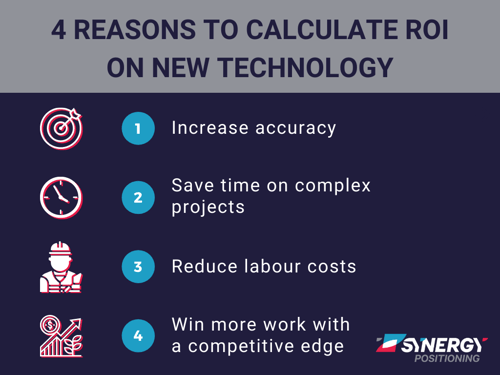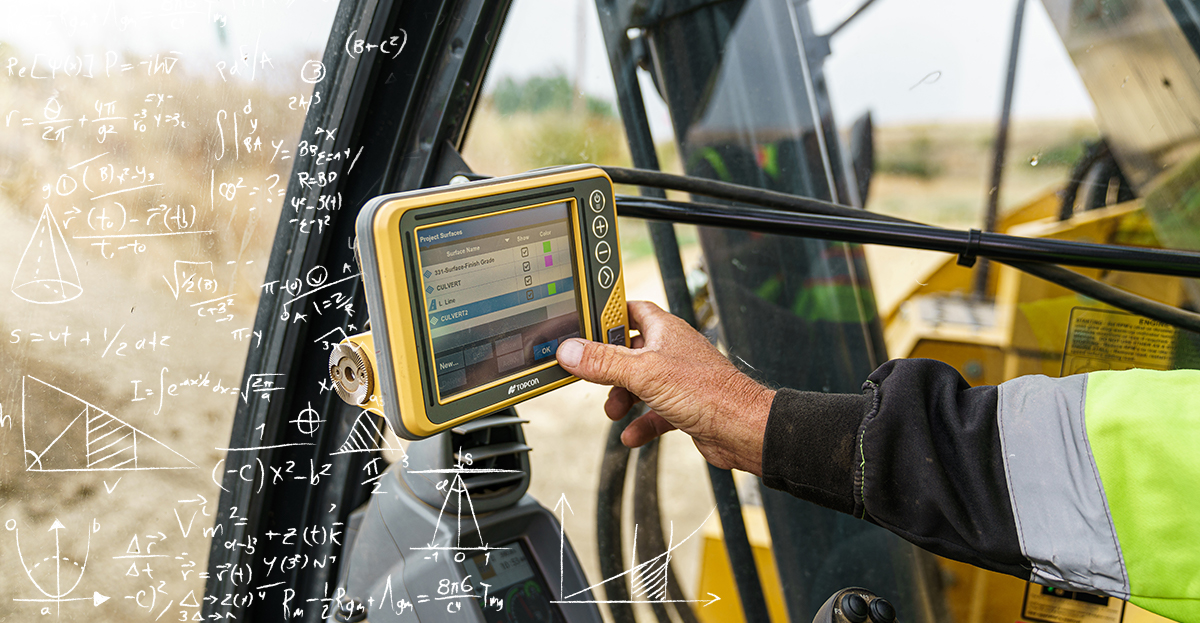How Do You Calculate ROI For New Technology?
With next generation construction technology and machine control systems comes the potential to increase productivity as well as profitability during projects. But how do you calculate your return on investment, or ROI?
This blog explores the four key reasons you need to be calculating ROI before you make the decision to invest in new technology, along with how to calculate ROI using multiple ways for different construction applications.

1) Increase accuracy
Comparing the accuracy that can be achieved on site using the latest construction technology will greatly contribute to the ROI of a project, thanks to the precision of GNSS and machine control systems. When considering the traditional process of a grading project, operators previously had to measure accuracy by completing a section, before physically needing to check that they are within the tolerance, and then moving on to the next section.
Thanks to GNSS and angle sensors, operators are able to verify their accuracy on the display unit in the cab in real time. This is because the software compares the design specifications that have been uploaded by the operator, to the physical location of the machine’s bucket or blade, and then calculates it’s exact position in order to achieve incredible accuracy as the machine moves.
During a recent local roading project, a performance comparison was recorded to assess the returns that could be achieved using machine control. During the grading portion of the project, comparisons were made between the time it took, the tolerance achieved, as well as the final appearance of the grade. Without machine control systems in place, one portion of the grading took around 19 minutes, achieved a tolerance of 41.6%, and still had a final appearance with many undulations. In contrast, with machine control, the grading took around 8 minutes, achieved a tolerance of 83.33%, and had an extremely smooth final grade appearance.
This level of accuracy and certainty on site leads to increased ROI by taking out any of the guesswork and enabling clear-cut forecasting of future tasks and projects.
2) Save time on complex projects
Not only do operators have the ability to program design specifications straight into the software, but some CAD applications also give access to various predefined templates for unusual and complex shapes, that simply need to be adjusted according to the measurements of the design. Prep work is also significantly reduced when it comes to surveyors needing to stake out specific shapes, as well as labourers needing to spend countless hours measuring unique shapes for accuracy.
This allows operators to consistently work within a fine tolerance, but also saves time entering design specifications from scratch. This has major implications in regard to efficiency, and will play a big role in the returns that can be generated.
3) Reduce labour costs
Additional time will come from labourers not having to check and recheck work throughout a project. Some of these checks will be reduced to once or twice a day as necessary. This leaves crewmembers with more time to complete other high priority tasks on the list, as opposed to having to do things like assist a machine operator.
Going back to the local roading project as a great example, it’s clear that there was a noticeable difference between the number of staff needed with and without machine control systems. Without next generation equipment, they required seven people on site - one operator, an operator helper, three grade check helpers, and two surveyors. In contrast, with machine control systems in use, they only required one operator and one surveyor.
Another advantage of machine control systems that will generate positive ROI is the professional development of crewmembers. Considering how simple and intuitive most systems are, even novice operators will be able to pick up these processes far quicker than learning traditional processes like setting up manual equipment. Machine control systems will allow them to set up projects in a matter of minutes, leaving them to get on with the job.
4) Win more work with a competitive edge
Clients understand that their projects will be completed with more accuracy, in less time, and to a higher standard with next generation equipment. For these reasons, they will be more likely to give you their work thanks to the increased productivity and often lower costs. Additionally, with machine control systems, you’re able to carry out much more complex projects. This means that you are able to bid on projects that aren’t even feasible for contractors who have not yet adopted these systems.
How to Calculate ROI
Typically, ROI is calculated by taking the actual or estimated revenue of a project and subtracting the actual or estimated costs. The result is the total profit that a project has, or is expected to generate upon completion. Usually ROI is calculated after a project is completed, however if you need to determine whether or not it makes financial sense to pursue a particular project, then it will be necessary to anticipate the ROI beforehand.
To make things easier, Topcon has created four ROI calculators that take into account the costs associated with various construction projects, and help to easily estimate ROI. The four calculators include one specifically for road work calculations, one for sitework, one for general construction, and one for pipeline and trenching work. There is also a tool to make measurement conversions, as well as calculate material quantities and costs for a project.
If you’re ready to start calculating your profitability to show your clients the potential financial results that you could achieve, click here to take a look at the Topcon calculators.
Or, if you'd like to talk to us about how you can incorporate machine control systems into your next project to start generating positive returns, get in touch today!



